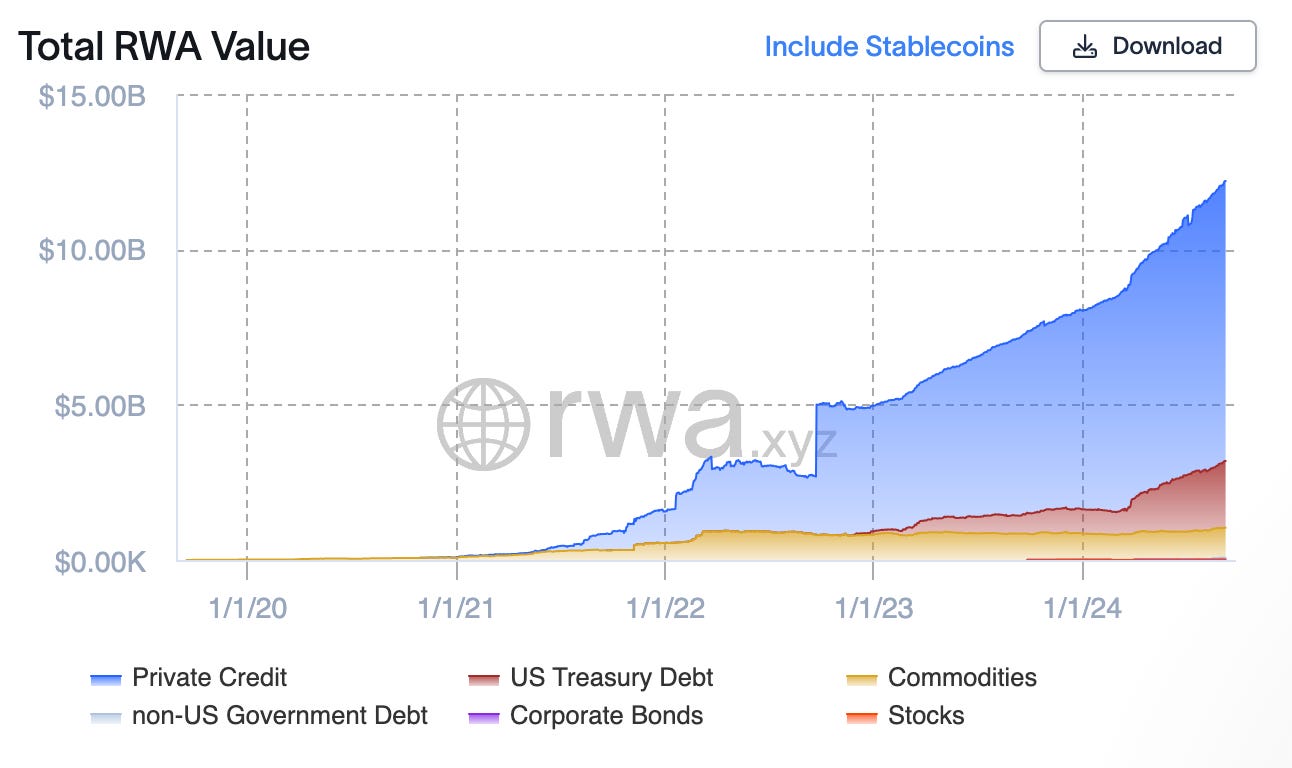Tokenization's 'Double Pedigree' Investing Advantages
Through tokenization of real-world assets investors can simultaneously invest in a traditional asset and its digital replica, potentially yielding dividends from both.
What if you could legally invest in the same asset twice at the same time?
With blockchain technology you can now invest in real-world assets (RWA) and their digital counterparts simultaneously. I am coining a term for this nascent investing strategy: the ‘double pedigree’.
By offering digital replicas of RWA on the blockchain, investors can potentially reap benefits from both the digital asset and its traditional counterpart at the same time. And as they are backed by hard assets, making them no different than an options or futures contract in terms of analyzing their value.
Let’s look at this budding new market so far.
RWA Tokenization Market Analysis
Tokenized RWA investing began to gain popularity during the 2022-2023 bear market when bond yields eclipsed decentralized finance (DeFi) yields, mainly driven by the Fed’s aggressive rate hikes at the time.
Concurrently, stablecoin yields began to compete with bonds as a “safe haven” for cash coming out of the money-printing bonanza that ocurred during COVID.
By the second quarter of 2024, U.S. Treasury bills offered an average yield of 5–5.24%. During the first half of 2024 asset tokenization projects yielded investors a 214% return while current projections say digitized assets will be valued at $2 trillion by 2030.
Institutional Adoption and Offerings
Adding in the recent institutional interest this year from firms like Franklin Templeton and Investcorp to offer tokenized RWAs, and we now have a $10 billion market cap on these digital assets.
Asset management firm BlackRock tokenized U.S. Treasuries on its BUIDL fund which rapidly garnered a market cap of $180 million; it now boasts a market cap of $517 million. BlackRock is now the largest issuer of tokenized treasuries after overtaking Franklin Templeton’s Benji Investment fund.
Here it must be emphasized that tokenized RWA is backed by hard assets and transacted using stablecoins whose value is pegged to stable hard currencies like the U.S. dollar and the Euro.
‘Double Pedigree’ Investing Advantages and Potential
There are distinct advantages to the double pedigree method. Here are just a few:
Familiarity and Trust: Traditional investors are often hesitant to dive into new technologies like blockchain due to unfamiliarity. By offering them a way to invest in tokenized versions of assets they already understand and trust, you're reducing the barrier to entry.
Diversification: The "double pedigree" approach could offer a unique form of diversification. If tokenized assets behave differently from their traditional counterparts due to factors like liquidity, market access, or investor base, this could allow investors to hedge their bets more effectively.
Regulatory Clarity: If regulations allow, this dual investment approach could lead to legal and compliant opportunities for investors to explore new financial technologies without risking their existing portfolios.
Innovation Incentive: This approach could incentivize more traditional investors to explore the blockchain space, thus potentially accelerating the adoption of tokenized assets.
Potential Challenges
Market Correlation: If the tokenized and traditional versions of the asset are highly correlated, the diversification benefits might be limited. In essence, investors might not be gaining much by holding both versions.
Liquidity and Market Size: Tokenized markets are generally less liquid and smaller than traditional markets. This could lead to issues with price discovery and increased volatility, which might deter risk-averse traditional investors.
Technological Risks: Blockchain technology and smart contracts are still relatively new and come with risks such as security vulnerabilities, technical failures, or issues with interoperability.
Tax Implications: The tax treatment of gains from traditional and tokenized assets might differ, leading to complex tax situations for investors. This could complicate the "double pedigree" strategy.
Conclusion
Though there are no laws in the U.S. forbidding simultaneous investing of the same asset in the traditional market, it does open the door to potential criminality such as insider trading, market manipulation, and conflicts of interest.
However, with tokenized RWA, an investor can buy into the the same asset twice – its physical asset and its digital counterpart. This opens the door to new market strategies, risk management, regulatory clarity, and even potentially doubling one’s profits.
I will be posting more about the details of methods and benefits to utilizing the ‘double pedigree’ investment strategy as these opportunities arise.





